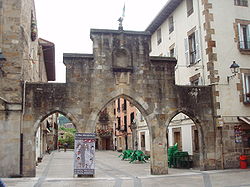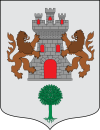Elorrio
| Elorrio | ||
|---|---|---|
| Municipality | ||

An archway in Elorrio
|
||
|
||
| Nickname(s): Elorrixo | ||
| Location of Elorrio within the Basque Country | ||
| Coordinates: 43°7′50″N 2°32′34″W / 43.13056°N 2.54278°WCoordinates: 43°7′50″N 2°32′34″W / 43.13056°N 2.54278°W | ||
| Country | Spain | |
| Autonomous community | Basque Country | |
| Province | Biscay | |
| Comarca | Durangaldea | |
| Founded | 1356 | |
| Government | ||
| • Mayor | Ana Otadui (EAJ-PNV) | |
| Area | ||
| • Total | 37.32 km2 (14.41 sq mi) | |
| Elevation | 185 m (607 ft) | |
| Population (2013) | ||
| • Total | 7,294 | |
| • Density | 200/km2 (510/sq mi) | |
| Demonym(s) |
Spanish: elorriano (ana) Basque: elorriotarra |
|
| Time zone | CET (UTC+1) | |
| • Summer (DST) | CEST (UTC+2) | |
| Postal code | 48230 | |
| Website | Official website | |
Elorrio is a town and municipality located in the province of Biscay, in the Basque Country, Spain. Elorrio is part of the comarca of Durangaldea and has a population of 7.117 inhabitants as of 2007 according to the Spanish National Statistics Institute.
In the Basque language, elorrio is the word for the red fruit (haw) of the common hawthorn. The Basque word elorri means "hawthorn". The coat of arms of the town shows a hawthorn. Colloquially, the town was called Elorrixo in Basque.
The Argiñeta tombs that today lie just outside the town of Elorrio are both pre-Christian and Christian (the earliest date of the latter is recorded as 893). In 1053, the San Agustín de Etxebarria monastery was founded, which in time was renovated and eventually became present-day church (an example of Gothic architecture). In 1356, Don Tello, Lord of Biscay, officially created Elorrio (through a foundational charter) on the land where the monastery stood, as a means of creating a town to defend his borders against invasion from neighboring Gipuzkoa. In 1468 the town was the site of a major battle between warring clan factions in the Basque Country (the Oñacinos and the Gamboinos). However, incidents of this type decreased, and between the sixteenth and the eighteenth centuries, the town's fortunes grew, gaining renown for its iron-forges, and especially the production of lances.
As a result of this economic expansion, a number of important buildings were constructed (mostly during the sixteenth century) that are today considered monuments of significant historical and architectural importance. In the nineteenth and early twentieth centuries, Elorrio, although it remained a predominantly rural town, became a tourist destination, as people visited the locality to attend one of its two well-known spas. After the Spanish Civil War, Elorrio went through a period of industrialization, with a number of small, family firms and worker cooperative enterprises emerging. In 1964, the whole town was the first one in Biscay to be declared a Centre of Historical and Artistic Importance. Its population, which grew from 3,500 in 1950 to 8,000 in 1981, currently (2004 records) numbers just over 7,000 people.
...
Wikipedia


